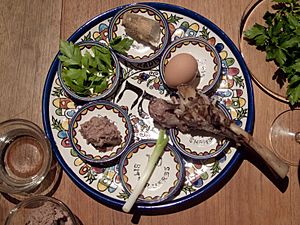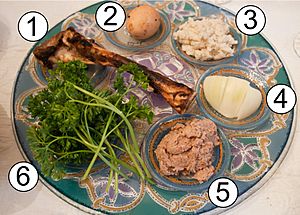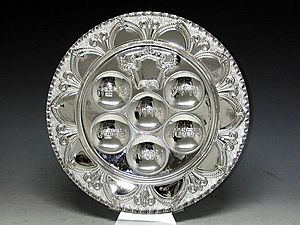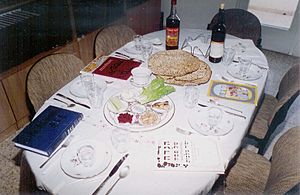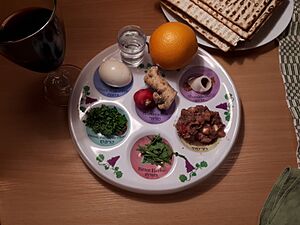Passover Seder plate facts for kids
The Passover Seder plate (called ke'ara in Hebrew) is a special plate. It holds important symbolic foods used during the Passover Seder. The Seder is a special meal where Jewish families remember the story of their ancestors leaving slavery in Egypt.
The Seder plate helps show all the ideas of the Jewish people. It makes the Seder meal unique and helps keep the special foods close by.
Contents
The Special Foods of the Seder Plate
Each of the six items on the Seder plate has a special meaning. They help tell the story of Passover, which is about the Exodus from Egypt. This story is the main focus of the Seder meal. There is also a seventh item, three matzos, which are used during the meal but are not usually on the Seder plate itself.
Here are the six traditional items you'll find on a Seder Plate:
Maror and Chazeret
Maror and Chazeret are bitter herbs. They remind people of the harsh and bitter slavery the Jewish people faced in Egypt. Many Jewish families use fresh romaine lettuce or horseradish for Maror. Chazeret is usually romaine lettuce. It is used to make a special sandwich called korech.
Charoset
Charoset is a sweet, brown mixture. It looks like the mortar and bricks that the Jewish slaves used to build buildings in Egypt. In many Jewish homes, Charoset is made from chopped nuts, grated apples, cinnamon, and sweet red wine.
Karpas
Karpas is a vegetable, usually parsley. It stands for hope and new beginnings, like springtime. At the start of the Seder, you dip the Karpas into salt water. The dripping water reminds people of the tears the Jewish slaves cried in Egypt.
Normally, at a Shabbat or holiday meal, bread is eaten first after a blessing. But at the Seder, a vegetable is eaten first. This leads to the famous question, Ma Nishtana—"Why is this night different from all other nights?"
Zeroah
The Zeroah (or Z'roa) is usually a roasted lamb shank bone. It's the only meat item on the Seder Plate. It reminds people of the Korban Pesach, which was a special lamb sacrifice. This sacrifice was made when God "passed over" the homes of the Israelites during the tenth plague in Egypt.
Beitzah
The Beitzah is a roasted egg. It reminds people of another sacrifice called the korban chagigah, which was offered at the Temple in Jerusalem. The egg is also a symbol of mourning. It helps people remember the sadness of the Temple being destroyed. The egg also represents the circle of life: birth, life, and death.
Many Seder plates you can buy have special spots for each of these symbolic foods.
Three Matzot
On the Seder table, there is also a plate with three whole matzot. They are stacked and separated by cloths or napkins. The middle matzah is broken, and half of it is saved for the afikoman. The top matzah and the other half of the middle matzah are used for a blessing over bread. The bottom matzah is used for the korech (a special sandwich).
Salt water
A bowl of salt water is placed next to the Seder Plate. It is used for the first "dipping" during the Seder. The salt water represents the tears of the Jewish people when they were enslaved in Egypt.
Different Seder Plate Traditions
- Vinegar – Some Jewish families, especially German and Persian Jews, include vinegar on their Seder plate. The karpas is dipped in vinegar instead of salt water.
- Orange – Some Jews include an orange on the Seder plate. The orange is a symbol of inclusion for all Jews. It shows that everyone should be welcome and able to take part fully in the Jewish community. This tradition started to show support for people who might feel left out. When people eat a piece of the orange, they spit out the seeds. This symbolizes getting rid of ideas that keep people apart.
See also
 In Spanish: Plato del Séder para niños
In Spanish: Plato del Séder para niños


